Concrete grinding and polishing is an undeniably economical and efficient way to strengthen and beautify your concrete floor. A professionally done job brings out the natural beauty of any concrete type, improving the floor's aesthetics and value. Concrete grinding and polishing is also an environmentally friendly, low maintenance, and sustainable flooring solution.
Notably, there are two primary methods for polishing: the "dry" and "wet." Though similar in principle, the two methods have several differences, with each offering distinct benefits. Choosing the ideal method for your floor is a crucial step to achieving the best outcome. Read on as we compare and contrast the many benefits of wet and dry grinding and polishing and help you choose what application is ideal for your project.
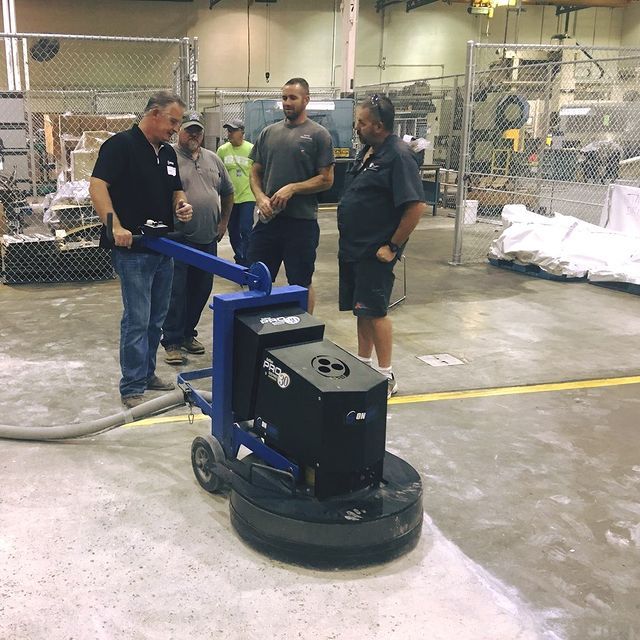
What Is Concrete Grinding and Polishing?
Concrete grinding is when rough surfaces are smoothened with a machine or equipment to improve their features. The process leverages heavy machinery and myriads of discs acting more like sandpapers. The concrete grinding process is typically done in several stages, with polishing being the final stage. During the final stage, very fine discs are USED to achieve excellent shine and unmatched smoothness.
Notably, both concrete grinding and polishing are used together to achieve an exceptional concrete surface that looks more like a polished stone. The benefits of concrete grinding are many and include:
- Durability: Polished concrete floors are not only strong, but they also last longer than regular floors. These floors are ideal for areas experiencing high traffic as they tend to hold up easily. Grinding and polishing of concrete floors can help stop chipping, stains or discoloring.
- Easy to maintain: Concrete floors that are ground and polished are easy to maintain. All you need to do is sweep and mop the floor to remove dust or dirt.
- Affordable: In high traffic areas, grinding and polished concrete floors need refreshing after 7 to 10 years. Therefore, it is a cost-effective option in the long run compared to other types of flooring options out there.
- Eco-friendly: The process of concrete grinding removes a meager amount of waste, making it one of the most eco-friendly flooring options out there. Besides, the floors that go through grinding and polishing improve air quality by reducing mold or dust.
- Improves safety: Grinding and polishing concrete floors result in high glossy surfaces that look attractive while reflecting the light. This helps create a safe environment for workers and also helps reduce your overall lighting cost.
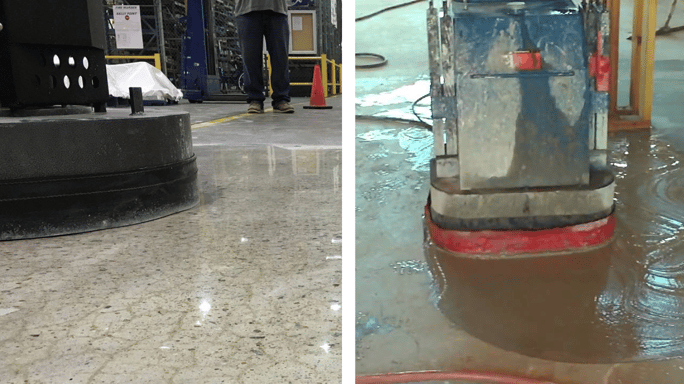
Wet vs. Dry Grinding and Polishing: Where Is the Difference?
The dry grinding and polish method: Dry polishing uses a range of commercial-scale polishing machines to ground the surface of the concrete. The machine is designed for grinding specific concrete to produce the desired shine. During the earlier stages of the process, a diamond grit with coarser textures is usually incorporated into the diamond disc. However, a finer one is used to achieve a final shine. Modern grinders and polishers designed for dry polishing can be attached to dust extraction systems to collect dust as it's being made.
The wet polishing method: During the wet polishing method, water is applied to the concrete to keep the diamond abrasives at standard temperatures and capture the dust in a slurry state to keep it out of the air. Although the polishing discs for this method share the same grit size, the final product typically features a low luster shine.
Wet vs. Dry Grinding and Polishing: The Pros and Cons
Wet Grinding and Polishing Pros and Cons
Pros
Increases diamond lifespan: Wet grinding and polishing increase diamond tooling lifespan while allowing for more aggressive grinding. It also keeps the diamond tooling cooler, thus preventing metal bonds from glazing over. This allows for the diamond to cut much faster on medium hard and extremely hard floors.
Removes ugly scratches: Using water during the initial stages of the process helps remove unsightly scratches left behind by the metal bond diamonds, ensuring you achieve a duller and easier to maintain shine level on your floors.
No dust: With wet grinding, there is absolutely no airborne dust, which reduces the need for dust collectors, respirators, and vacuums, thus translating to lower operation costs. The water also protects the user from being exposed to toxic silicon particles that can impact their health.
More familiarity: Wet concrete grinding and polishing were developed long before the dry grinding method. It is, therefore, a natural choice for seasoned contractors, especially in locations with an abundance of water supply.
More options: Wet polishing produces consistent finish in a range of flooring materials from porcelain, marble, terrazzo, quartz, limestone, travertine to the hardest granite.
Less costly: Wet pads are typically less costly to purchase than dry pads. Using water with these pads also keeps the resin cool and stops the pads from overheating burning out too quickly, which means you won't have to replace your machine too soon if you choose this method.
Cons
Leads to waste: The large amounts of water needed for larger jobs can be wasteful, especially in situations where dry grinding is possible. With the rising cost of water, it may not be the best option for large-scale commercial projects.
Lower shine: It can be challenging to achieve the same level of shine with wet polishing as you could with the dry option. When aiming for decorative flooring or a premium shine finish, wet polishing may not be the best option.
Creates a mess: Although wet grinding can help keep you safe from dust exposure, it leaves a slurry mess that may require substantial amounts of time to clean up. Because the slurry leftover is not always easy to dispose of, it may result in many environmental issues.
A lengthier process: Normally, the wet grinding process takes more time than the dry method, translating to higher costs, especially in situations where the contractor charges you hourly for labor. Additionally, if the floor is to be coated, it must be dried for several days after wetting to achieve a moisture-free substrate before the coating process.

Dry Grinding and Polishing Pros and Cons
Pros
Deliver more shine: Dry polishing gives your floor a higher level of shine when compared to wet polishing. It also guarantees a higher level of light reflection and a more sophisticated-looking floor.
Ideal for a soft concrete floor: Dry polishing tends to work better for soft concrete. Polishing wet on these floors forces diamonds to grind over aggressively to leave unsightly gouge marks on the floors. This method also does more to the slab in terms of hardening and condensing.
Cleaner, faster job: Dry grinding is not only faster than wet grinding but also much easier to clean and keep neat because you don't have run-off and slurry problems to deal with. Since the surface is dry, it can be quickly vacuumed and coated immediately. With wet grinding, the slurry often sticks into the pores of the concrete to result in debonding issues once it dries and coating is applied.
Immediate results: With dry grinding, you can see the results immediately. The absence of slurry mess typical of wet grinding means workers can easily assess their work and make improvements where necessary.
Easy maintenance: With dry grinding, the machine is typically much easier to maintain as bearings are not exposed to wet conditions that lead to rusting and faster wearing.
Cons
Health hazards: Dry grinding leaves a cloud of dust that present substantial health hazards. The dust must be controlled to prevent respiratory health risks.
Added costs: With this method, you will need purpose-built dust collectors to collect dust and maintain a healthy airflow, making the equipment a little more expensive. There is also higher energy consumption per unit of mass with this method.
Risks of glazing: If an inappropriate tool is used, it may result in overheating, which leads to glazing. It may not also be an ideal option when dealing with very hard concrete.
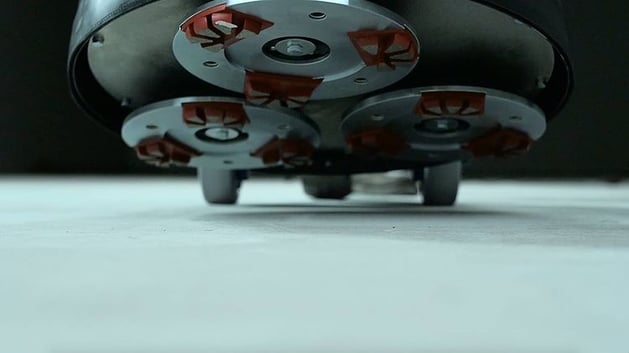
Wet vs. Dry Grinding and Polishing: Which method Is Greener?
The debate on the method that is greener between wet and dry grinding is still raging. Dry grinding ideally solves the disposal issue more efficiently since it doesn't produce a slurry mess. Notably, the regulations on slurry disposal vary from one state to another, and it is essential to research the regulations of your jurisdiction before choosing your preferred method.
Wet grading too addresses another primary environmental concern in the form of toxic silicon. As mentioned earlier, wet grinding and polishing remove dust clouds typical of a dry polishing process. Silicon from this dust is now a massive issue for the flooring industry. Even where ideal tax extractors are deployed, workers can still be exposed to substantial dust during a dry polishing process.
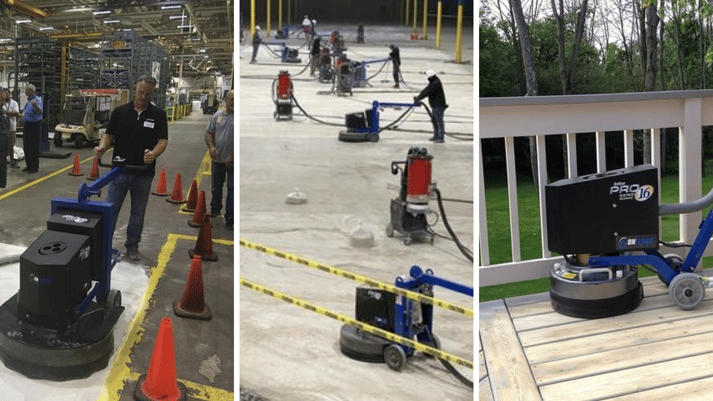
Where Can Concrete Grinding Services Be Used?
The applications for concrete grinding services are many as these flooring methods are ideal for both industrial and commercial buildings. Some of the places where concrete grinding and polishing are mostly used include:
- Warehouses
- Showrooms
- Hospitals
- Schools and universities
- Manufacturing units and more
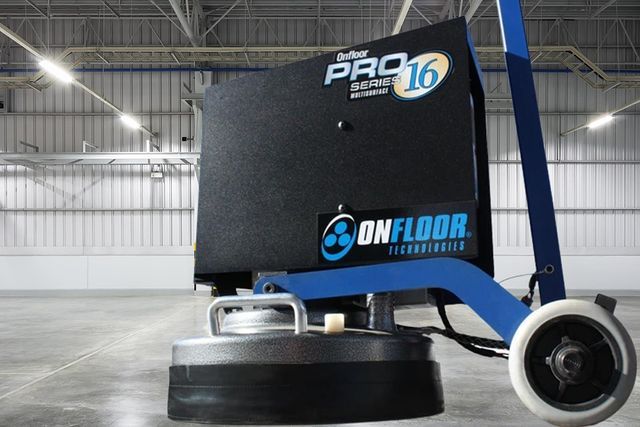
Which Is Better? Wet or Dry Concrete Grinding?
At Onfloor we get asked this question daily by homeowners and commercial property owners looking to upgrade their flooring. The truth is that there is no definitive answer to this question as both methods present distinct advantages and disadvantages. Some factors that determine the ideal method to choose include your preferences, budget, available time, and other factors.
Notably, if you are a business in the food and beverage industry, you are typically required by law to use a dust-free polishing method, meaning a wet polish method will be a must. Other types of businesses that want to impress their clients with a high gloss floor can get better results with the dry method.
We recommend a balance of both methods depending on your individual needs. When dealing with extremely hard concrete, it is best to start with the wet grinding method before switching to the dry grinding method afterward. Ideally, crews can grind wet to remove a significant layer of concrete to expose aggregate and polish dry to achieve a high shine on the floor.
Get Professional Help
Quality concrete grinding and polishing require an experienced contractor. Bad flooring doesn't only ruin the entire appearance of your flooring; it is also costly to remedy. Don't allow inexperienced people to update your floors. If you are unsure about the right method to use for your floor or need exceptional flooring services, co
3 comments